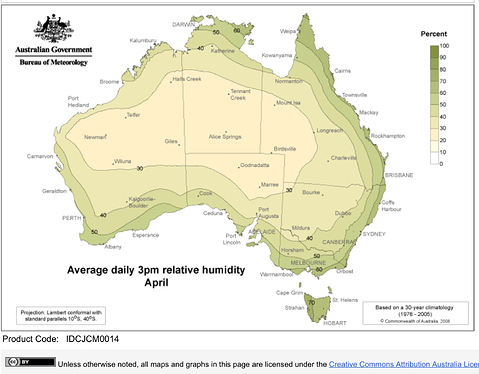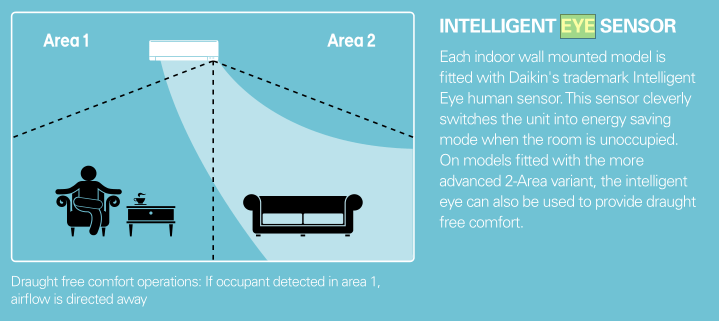If there is a consensus indoor relative humidity should be kept below 50%,this seldom happens in the Coastal Temperate Zone of Australia.
Out of doors you can adjust and the environment is what it is. Outside it has been raining on and off most of the last
three days. Suitably attired in gumboots, long sleeves and strategic use of DEET, it will only take five minutes of walking to look like a wet dish rag.
It’s simply a recommendation for healthy indoor environments. Also likely to encourage the uptake of air conditioning or refrigerant dehumidifiers.
One view from the National Asthma Foundation.
And a polite piece of marketing from one well known to Air Conditioning professionals.
Of course not everyone lives in air conditioned home. Many of us prefer natural ventilation, ceiling fans and go with the ebbs and swings of climate. Some of us even pretend to enjoy being dripping wet from perspiration, hopefully not too close to heat exhaustion. Our SE coastal Qld air cons are on at present. Set to 27C all they are really doing is pulling some of the moisture from the air. Better than that dank musty smell of a damp room.
At 27 degrees, I would not have thought that they would be doing anything as they probably wouldn’t be producing much cold air.
Ours are set to 24 degrees as usual. The ABC News website shows Mt Sheridan being currently 31 degrees and feeling like 35 degrees with 66% humidity.
The Centameter display in our kitchen is showing 24.0 degrees and 52% humidity.
It usually does not get down to 24 degrees but it has been raining and the temperature has dropped.
I never suggested that at all. I was having a problem with the idea that there are more health problems with high humidity than with low.
30C in summer in tropical Cairns or 30C in Longreach on a dry and warm winter day. The feeling is not the same.
Lowering higher relative humidity using the split system, and providing air movement with large ceiling fans works. Carrying body heat and moisture away is effective. A side benefit is reduced power usage of 25-50% depending on the outside temperature difference.
In winter the target is a modest 18C.
It is called apparent temperature…
and is often reported by BOM to give an indication of how comfortable the prevailing weather is.
Coastal Temperate Zone in Autumn and Spring there are numerous days of 20c with a RH of 100% ,and with inside RH similar.To run an A/C to remove Humidity would reduce the temp.to uncomfortable levels.
In a domestic situation where the system doesn’t have re-heat you probably wouldn’t run the aircon at 20 C regardless of RH. In commercial situations that do have re-heat it is done often.
In commercial systems they usually use a by pass system where the air over the coil is reduced causing a lower coil temp which dramatically reduces the RH without needing heating.
This has moved on a little from simply meeting needs in winter in Tasmania.
Isn’t 100% RH equivalent to a heavy fog?
Other than some very early cool mornings BOM data suggests RH above 60-70% is somewhat uncommon, on the eastern coastline. Certainly by mid afternoon when temperatures are highest.
Most residential RC Air Conditioners also operate in drying mode. Assume this is similar to how a refrigerant dehumidifier works? For an RC air conditioner that can both chill some of the room air to reduce moisture and reheat air if the room is too cold, is this a real concern? We’ve never needed to do this despite our near coastal location in SE Qld.
In everyday living most of us probably aren’t all that concerned with the RH inside the house once the AC is turned on. We probably adjust the temperature until it feels right.
P.S.
For the curious? There is a balance between heat gain or loss in an air conditioned house, vs the thermal energy transferred into or out of the house/rooms by an air conditioner (heat pump). The AC head (coils) operate at a temperature above or below the room set point for efficient operation. There is a mixing of air that has passed through the AC head (coils) and the air in the room. Not all room air is cooled or heated directly by the AC. It’s the mixing of the air that is also important. Choice values the distance or throw of the air when reviewing ACs. It assists in mixing and uniformity of temperature in the room. Ceiling fans are also effective.
BOM data may suggest that 60-70% is somewhat uncommon, however the RH for the last week where I live hasn’t agreed with them.Today 24c Dry Bulb 22c Wet Bulb, and it’s not varied much over the past week.100% RH can be a heavy fog however with coastal atmosphere you don’t need a heavy fog to produce between 90-100%RH.BOM W/Site shows temps for the next week 27c,25,22,22,22,23,25,and on past readings I would estimate that 80-85%Rh or higher will be the the norm.
Having ceiling fans on when operatingA/C on cooling is false economy.Running ceiling fans blow hot air down as the ceiling is the hottest place in the house.Cooling air from the A/C falls maintaining an ambient where people are.
Not always true except in theory. Many A/C units have a mode that blows the cold air across the ceiling to avoid a cold draft on the inhabitants. From personal experience a ceiling fan will distribute that cool air in a more gentle, less focused manner and enhance the general comfort of the room. Everything is not about economy for everyone, and comfort enters the equation for many. The cost of running a ceiling fan is minimal, especially on the lowest speed.
A/C is rarely a one size fits all depending on local climate, the building, human preferences, and issues of economy.
Fact :-Cold air falls ,hot air rises. Diffusers in most air conditioners allow for the adjustment of air flow to be directed to the most appropriate location in the room.
Some air conditioners also have sensors which can detect movement/people and direct airflow in the direction of the room’s occupants.
I wonder could you tell me the particular A/C which directs airflow in the direction of the rooms occupants?
Daikin has this feature…it is called ‘Intelligent Eye’. There are possibly others as well.
Daiken’s Intelligent Eye only detects the presence of people, it hasn’t a function of selectively directing airflow.
It has a very rudimentary function, the details not for here, but rather than ‘aiming’ airflow at people it follows the ‘comfort mode’ setting under circumstances.
and this is what the manuals says:
While it doesn’t follow a person around a room, it direct airflow in the general direction of persons (or away from persons if this option is selected) within a room. It also goes into energy saving mode when it detects that the room has been vacated for 20 minutes.



